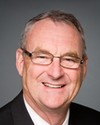That would be absolutely tremendous, Mr. Chair. Thank you very much.
Thank you for everybody's time today.
The idea behind this project from the outset was to look for a new way for the right people to get introduced to the right opportunities the first time. When we're talking about “people”, we're talking about individuals, employers, communities, and groups. The idea was to find a way to do that in a way that creates the maximum amount of productivity and efficiency in the process.
The key to that, from our perspective, through a set of technologies we developed over the past four years, was to collect the right information the right way the first time. By “right information”, we're talking about the way in which an individual would profile themselves to talk about what their key skills are and talk about the types of opportunities they're most interested in in the marketplace, the way in which a company would profile a job opportunity they have for the marketplace, or the way in which a group might profile the types of members they're looking for in the marketplace to create the most amount of benefit to all sides.
We've developed that technology, as I said, over the past four years. The idea was to create those matches not only one time but all the time. As an employer or as a peer introduces an opportunity for themselves to connect with the marketplace, that opportunity is in fact activated to go find the right people. That's why the process is reversed from the normal process.
The normal process today, of course, is that people actively look for jobs, and oftentimes technology is getting in the way of those people actively looking for jobs. It's getting in the way because employers are getting hundreds or thousands of résumés for every opportunity they post. They don't have the time to get through these résumés. Oftentimes the people who are looking for the jobs don't get very professional responses from those organizations because the volume is just too high. We're looking for ways to eliminate that, to connect the right people the right way the first time.
On top of that, as we developed these programs over the last several years we learned that more than just matching had to happen in order to actually complete the solution. We learned that, number one, connections needed to happen in a very fast and efficient way. On top of the matching algorithms that we developed, on top of the way we were able to actually bring communities together, we developed communications technologies that will allow for instant communications when a match actually happens.
When we develop the software, it's more than just a typical job board scenario whereby you have somebody advertising a job and somebody looking on that job board. We actually aggregate data from the Globe 1000 public companies, the Globe 350 private companies, the Forbes 2000, and eventually thousands of SMEs. The idea is that we're always keeping track of what's happening from an analytical perspective in the marketplace.
The reason for this is that we're able to give people an understanding not only for why they are matched to something but also for why they're not a match to something. Imagine a world—in just a couple of years, we think—where we're tracking all of these large corporations in North America, and specifically in Canada, we're tracking hundreds of thousands or millions of people, and we're able to actually take a look at the skills banks that we've created to define what the skills are on a by-job and by-industry and by-person basis against all of the data that we're collecting in the marketplace.
The idea, of course, is that we can start to understand from an analytics perspective what's happening with the labour pool, what's happening with industry, and how it's changing—and not a year from now, but now.
The idea is to understand what's happening from a labour pool and job perspective, those jobs in the marketplace, and how the conditions are evolving, and always understand specifically what the individuals are doing in that marketplace in terms of aggregate data so that we can compare those two data sets.
In doing that, there's the communications capability, which is a real-time communications capability so that people can talk on video as soon as they're connected. There's also a presentations capability. We've learned in working with Ryerson that it's more than just about the skills; it's also about how you demonstrate those skills. It's about how you actually demonstrate the value that's associated with the work that you've done. We've developed some advanced but simple-to-use presentation capabilities.
So front to back, we profile, we match instantly, we communicate very quickly. We can do so in such a way that files of candidates are kept for corporations. We present both the corporation's value as well as the individual's value in the context of a series of multimedia presentations. That happens on a 24/7 basis with all of the largest corporations in North America and specifically Canada.
That's what the technology is about.




